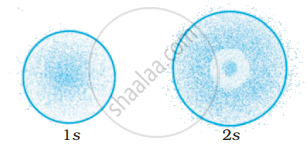Advertisements
Advertisements
प्रश्न
Write condensed orbital notation of electronic configuration of the following element:
Calcium (Z = 20)
उत्तर
| Element | Condensed orbital notation |
| Calcium (Z = 20) | [Ar] 4s2 |
APPEARS IN
संबंधित प्रश्न
Using s, p, d notations, describe the orbital with the following quantum numbers n = 1, l = 0.
Using s, p, d notations, describe the orbital with the following quantum numbers n = 3; l =1.
State Heisenberg uncertainty principle.
State Hund’s rule of maximum multiplicity with a suitable example.
Explain the anomalous behaviour of copper.
Explain the anomalous behaviour of chromium.
Write orbital notations for the electron in orbitals with the following quantum numbers.
n = 4, l = 2
Explain in brief, the significance of the azimuthal quantum number.
The electronic configuration of oxygen is written as 1s2 2s2 \[\ce{2p^2_{{x}}}\] \[\ce{2p^1_{{y}}}\] \[\ce{2p^1_{{z}}}\] and not as 1s2 2s2 \[\ce{2p^2_{{x}}}\], \[\ce{2p^2_{{y}}}\] \[\ce{2p^0_{{z}}}\], Explain.
Write a note on ‘Principal Quantum number.
Indicate the number of unpaired electrons in \[\ce{Si}\] (Z = 14).
How many electrons in 19K have n = 3, l = 1?
The three electrons have the following set of quantum numbers:
X = 6, 1, −1, `+1/2`
Y = 6, 0, 0, `+1/2`
Z = 5, 1, 0, `+1/2`
Identify the CORRECT statement.
Which of the following has a greater number of electrons than neutrons?
(Mass number of Mg, C, O and Na is 24, 12, 16 and 23 respectively).
Which of the following options does not represent ground state electronic configuration of an atom?
The probability density plots of 1s and 2s orbitals are given in Figure:

The density of dots in a region represents the probability density of finding electrons in the region.
On the basis of above diagram which of the following statements is incorrect?
Number of angular nodes for 4d orbital is ______.
Total number of orbitals associated with third shell will be ______.
The pair of ions having same electronic configuration is ______.
Out of the following pairs of electrons, identify the pairs of electrons present in degenerate orbitals:
| (i) | (a) `n = 3, l = 2, m_l = -2, m_s = - 1/2` |
| (b) `n = 3, l = 2, m_l = -1, m_s = - 1/2` | |
| (ii) | (a) `n = 3, l = 1, m_l = 1, m_s = + 1/2` |
| (b) `n = 3, l = 2, m_l = 1, m_s = + 1/2` | |
| (iii) | (a) `n = 4, l = 1, m_l = 1, m_s = + 1/2` |
| (b) `n = 3, l = 2, m_l = 1, m_s = + 1/2` | |
| (iv) | (a) `n = 3, l = 2, m_l = +2, m_s = - 1/2` |
| (b) `n = 3, l = 2, m_l = +2, m_s = + 1/2` |
In which of the following pairs, the ions are iso-electronic?
(i) \[\ce{Na^{+}, Mg^{2+}}\]
(ii) \[\ce{Al3^{+}, O-}\]
(iii) \[\ce{Na+ , O2-}\]
(iv) \[\ce{N3-, Cl-}\]
The electronic configuration of valence shell of Cu is 3d104s1 and not 3d94s2. How is this configuration explained?
What is the difference between the terms orbit and orbital?
Match the following
| (i) Photon | (a) Value is 4 for N shell |
| (ii) Electron | (b) Probability density |
| (iii) ψ2 | (c) Always positive value |
| (iv) Principal quantum number n | (d) Exhibits both momentum and wavelength |
Match species given in Column I with the electronic configuration given in Column II.
| Column I | Column II |
| (i) \[\ce{Cr}\] | (a) [Ar]3d84s0 |
| (ii) \[\ce{Fe^{2+}}\] | (b) [Ar]3d104s1 |
| (iii) \[\ce{Ni^{2+}}\] | (c) [Ar]3d64s0 |
| (iv) \[\ce{Cu}\] | (d) [Ar] 3d54s1 |
| (e) [Ar]3d64s2 |
Choose the INCORRECT statement
In the case of R, S configuration the group having the highest priority is ______.
